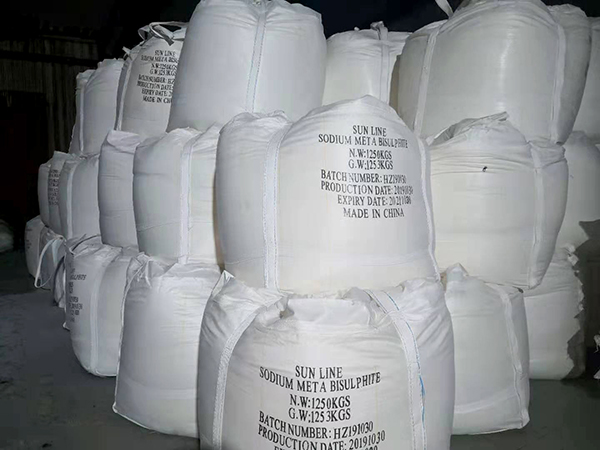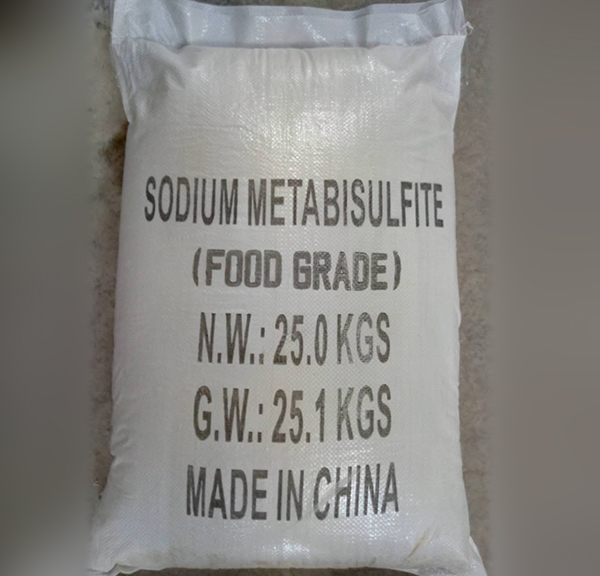Sodium metabisulfite ~ English name: Sodium? pyrosulfite, also known as heavy sulfur oxide, also known as partial sodium sulfite, or sodium disulfite molecular formula is NaS205, molecular weight 190.1? White or yellowish crystalline powder, relative density 1.4. Soluble in water and glycerin, slightly soluble in ethanol, insoluble in benzene. Its solubility in water increases with increasing temperature. It is 54g/100mL water at 20℃ and 81.7g/100mL? water at 100℃. The aqueous solution is acidic and generates stable sodium sulfite when dissolved in water. It is easy to decompose when exposed to moisture. It can easily oxidize and release SO2 in exposed air. Finally, it absorbs oxygen and is oxidized to Na2SO4. When it comes into contact with strong acid, it emits SO2 and generates corresponding salts. Adducts are formed, and solid sodium metabisulfite begins to decompose when heated to 150 degrees, which is toxic if ingested. Sodium metabisulfite products are divided into industrial grade and food grade, and their quality indicators are different. Industrial grade sodium metabisulfite is widely used. The pharmaceutical industry is used to produce chloroform, phenylpropyl sulfone and benzaldehyde purification, the rubber industry is used as a coagulant, the printing and dyeing industry is used as a dechlorination agent for cotton cloth bleaching, the cotton cloth smelting aid and the mordant for printing and dyeing, and the leather industry For leather treatment, it can make the leather soft, plump, tough, with waterproof, flexural, abrasion resistance and other properties. Chemical industry is used to produce hydroxyvanillin, hydroxylamine hydrochloride, etc., and photosensitive industry is used as a developer.
Food grade sodium metabisulfite can be used as bleaching agent and leavening agent for biscuits and cakes, nutrient retention agent for dehydration of vegetables, preservative for storing fruits, sterilization preservative for brewing and beverages, etc. The hygienic standard for the use of food additives in my country (GB2760-86) stipulates the use standard of sodium metabisulfite: wine and fruit wine. 0.25g/kg; sugar, bamboo shoots, candied fruit, biscuits, canned food, vermicelli, sugar should not exceed 0.05g/kg, and brown sugar and other varieties should not exceed 0.1g/kg.

Pay attention to the following points when using sodium metabisulfite when processing food:
1) Substances bleached with sulfites are easy to recolor due to the disappearance of sulfur dioxide, so usually excess sulfur dioxide remains in food, but the residual amount should not exceed the standard.
2) When metal ions are present in the food, the residual sulfurous acid can be oxidized; it can also oxidize and change the reduced pigment, thereby reducing the effectiveness of the bleach. Therefore, metal chelating agents are also used during production.
3) Sodium metabisulfite solid reducing bleach, its solution is unstable and volatile, and it is used now to prevent unstable and volatile sulfite.
4) Sulfite reacts easily with aldehydes, ketones, proteins, etc.
5) Sulfite can destroy thiamine, so it is not easy to use in fish food.
6) Sulfurous acid cannot inhibit the activity of pectinase, which will damage the cohesion of pectin. In addition, after sulfurous acid penetrates into the fruit tissue, the fruit can be crushed during processing to remove sulfur dioxide. Therefore, fruits preserved with sulfurous acid are only suitable for making jams, dried fruits, fruit wine, preserves, etc., and cannot be used as raw materials for canning.

◆ Export Business Department Ⅰ:Mr.Steven Sun
+86-15822712322
E-mail:steven@huizhongchem.com
◆ Export Business Department Ⅱ:Ms. Katherine Yang
+86-13752275385
E-mail:katherine@huizhongchem.com
◆ Factory add.:Nanpu Economic and Technological Development Zone,Tangshan
Office add.:A1-406,TEDA New Skline Mansion,No 12 Nanhai Road,TEDA Tianjin
![]()
